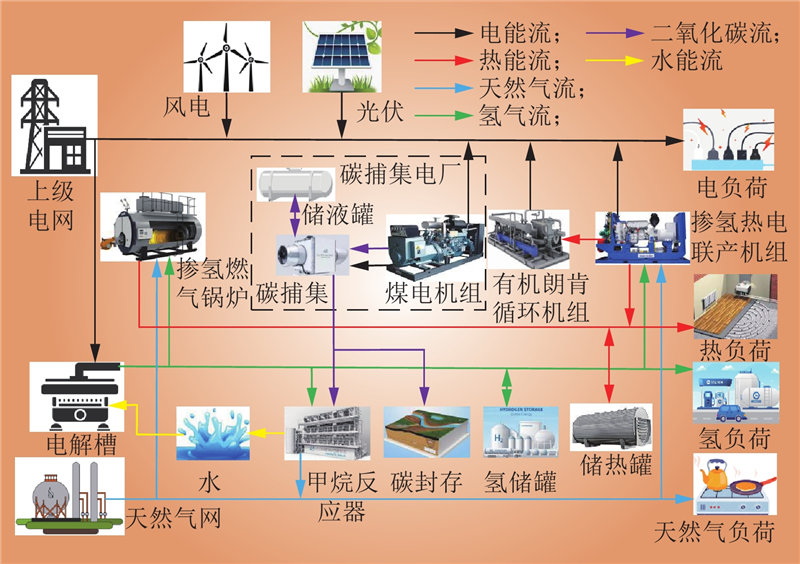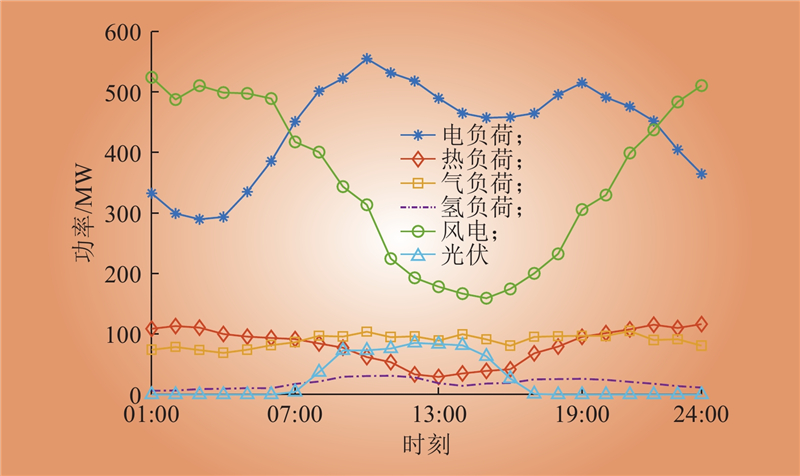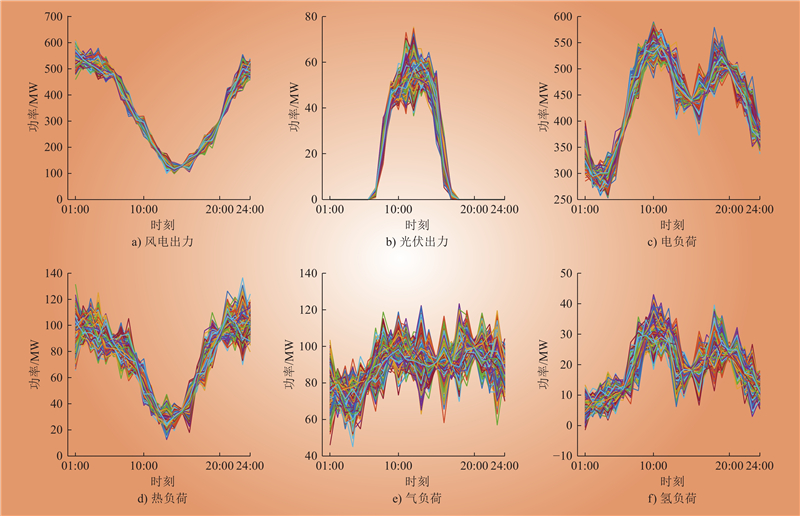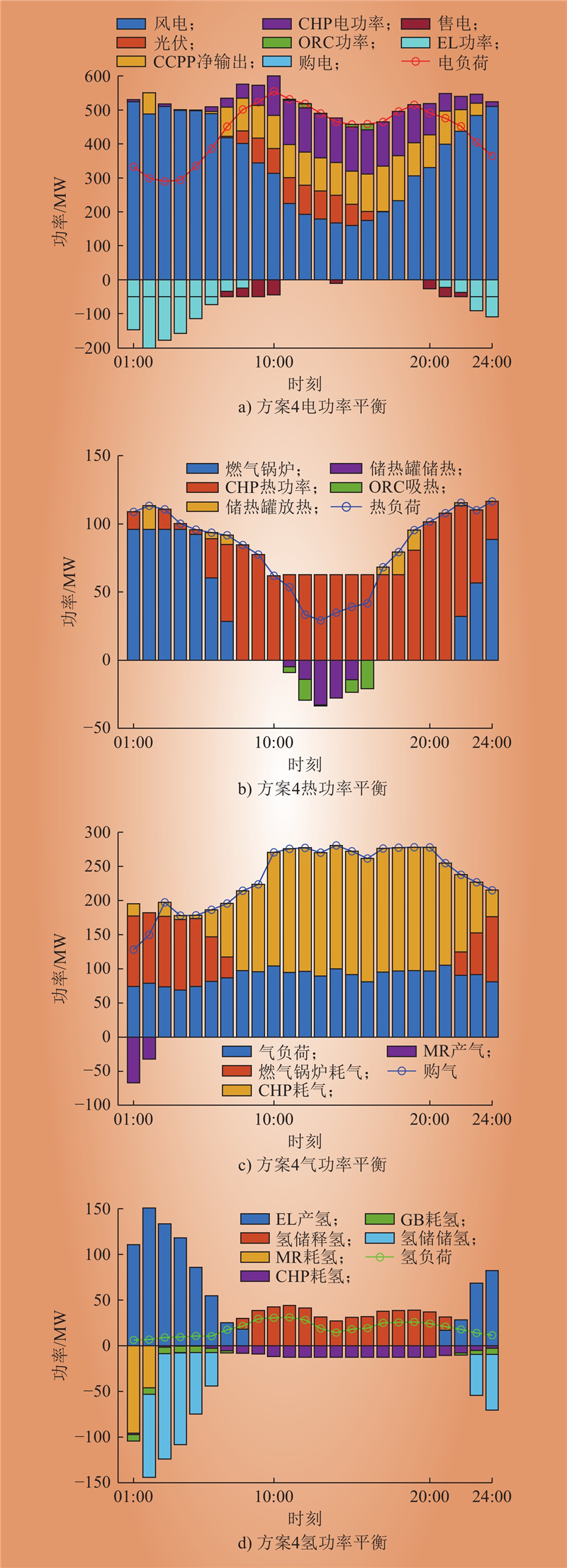| 1 |
李红伟, 吴佳航, 王佳怡, 等. 计及P2G及碳捕集的风光氢储综合能源系统低碳经济调度[J]. 电力系统保护与控制, 2024, 52 (16): 26- 36.
|
|
LI Hongwei, WU Jiahang, WANG Jiayi, et al. Low-carbon economic dispatch of a wind, solar, and hydrogen storage integrated energy systemconsidering P2G and carbon capture[J]. Power System Protection and Control, 2024, 52 (16): 26- 36.
|
| 2 |
刘珂, 顾雪平, 白岩松, 等. 考虑风电不确定性的电力系统在线动态分区恢复优化方法[J]. 电力系统保护与控制, 2024, 52 (19): 60- 73.
|
|
LIU Ke, GU Xueping, BAI Yansong, et al. nline dynamic partition restoration optimization method of a power systemconsidering wind power uncertainty[J]. Power System Protection and Control, 2024, 52 (19): 60- 73.
|
| 3 |
朱明, 夏宇栋, 常凯, 等. 基于粒子群优化算法的空调负荷灰箱模型辨识[J]. 电力科学与技术学报, 2023, 38 (4): 214- 221.
|
|
ZHU Ming, XIA Yudong, CHANG Kai, et al. Identification of grey box model for air conditioning load based on particleswarm optimization algorithm[J]. Journal of Electric Power Science and Technology, 2023, 38 (4): 214- 221.
|
| 4 |
朱霄珣, 刘占田, 薛劲飞, 等. 计及柔性负荷参与的综合能源系统优化调度[J]. 太阳能学报, 2023, 44 (9): 29- 38.
|
|
ZHU Xiaoxun, LIU Zhantian, XUE Jinfei, et al. Optimal scheduling of integrated energy system with flexible load participation[J]. Acta Energiae Solaris Sinica, 2023, 44 (9): 29- 38.
|
| 5 |
LI M S, LIN Z J, JI T Y, et al. Risk constrained stochastic economic dispatch considering dependence of multiple wind farms using pair-copula[J]. Applied Energy, 2018, 226, 967- 978.
DOI
|
| 6 |
王冠, 李鹏, 焦扬, 等. 计及风光不确定性的虚拟电厂多目标随机调度优化模型[J]. 中国电力, 2017, 50 (5): 107- 113.
|
|
WANG Guan, LI Peng, JIAO Yang, et al. Multi-objective stochastic scheduling optimization model for virtual power plant considering uncertainty of wind and photovoltaic power[J]. Electric Power, 2017, 50 (5): 107- 113.
|
| 7 |
杨晓峰, 方逸航, 赵鹏臻, 等. 基于K-means和BPNN的风机状态识别[J]. 中国电力, 2023, 56 (6): 158- 166, 175.
|
|
YANG Xiaofeng, FANG Yihang, ZHAO Pengzhen, et al. State recognition of wind turbines based on K-means and BPNN[J]. Electric Power, 2023, 56 (6): 158- 166, 175.
|
| 8 |
南斌, 姜春娣, 董树锋, 等. 计及源荷不确定性的综合能源系统日前-日内协调优化调度[J]. 电网技术, 2023, 47 (9): 3669- 3683.
|
|
NAN Bin, JIANG Chundi, DONG Shufeng, et al. Day-ahead and intra-day coordinated optimal scheduling of integrated energy system considering uncertainties in source and load[J]. Power System Technology, 2023, 47 (9): 3669- 3683.
|
| 9 |
崔杨, 邓贵波, 曾鹏, 等. 计及碳捕集电厂低碳特性的含风电电力系统源–荷多时间尺度调度方法[J]. 中国电机工程学报, 2022, 42 (16): 5869- 5886, 6163.
|
|
CUI Yang, DENG Guibo, ZENG Peng, et al. Multi-time scale source-load dispatch method of power system with wind power considering low-carbon characteristics of carbon capture power plant[J]. Proceedings of the CSEE, 2022, 42 (16): 5869- 5886, 6163.
|
| 10 |
贠保记, 张恩硕, 张国, 等. 考虑综合需求响应与“双碳”机制的综合能源系统优化运行[J]. 电力系统保护与控制, 2022, 50 (22): 11- 19.
|
|
YUN Baoji, ZHANG Enshuo, ZHANG Guo, et al. Operation of an integrated energy system considering integrated demand response and a "dual carbon" mechanism[J]. Power System Protection and Control, 2022, 50 (22): 11- 19.
|
| 11 |
朱振山, 盛明鼎, 陈哲盛. 计及液态空气储能与综合需求响应的综合能源系统低碳经济调度[J]. 电力自动化设备, 2022, 42 (12): 1- 8.
|
|
ZHU Zhenshan, SHENG Mingding, CHEN Zhesheng. Low-carbon economic dispatching of integrated energy system considering liquid air energy storage and integrated demand response[J]. Electric Power Automation Equipment, 2022, 42 (12): 1- 8.
|
| 12 |
张栋顺, 全恒立, 谢桦, 等. 考虑碳交易机制与氢混天然气的园区综合能源系统调度策略[J]. 中国电力, 2024, 57 (2): 183- 193.
|
|
ZHANG Dongshun, QUAN Henghua, XIE Hua, et al. Dispatching strategy of park-level integrated energy system considering carbon trading mechanism and hydrogen blending natural gas[J]. Electric Power, 2024, 57 (2): 183- 193.
|
| 13 |
朱西平, 江强, 刘明航, 等. 计及源-荷不确定性的综合能源系统两阶段优化调度[J]. 电力自动化设备, 2023, 43 (8): 9- 16.
|
|
ZHU Xiping, JIANG Qiang, LIU Minghang, et al. Two-stage optimal scheduling of integrated energy system considering source-load uncertainty[J]. Electric Power Automation Equipment, 2023, 43 (8): 9- 16.
|
| 14 |
邹宇航, 曾艾东, 郝思鹏, 等. 阶梯式碳交易机制下综合能源系统多时间尺度优化调度[J]. 电网技术, 2023, 47 (6): 2185- 2198.
|
|
ZOU Yuhang, ZENG Aidong, HAO Sipeng, et al. Multi-time-scale optimal dispatch of integrated energy systems under stepped carbon trading mechanism[J]. Power System Technology, 2023, 47 (6): 2185- 2198.
|
| 15 |
邢海军, 叶宇静, 刘哲远, 等. 含多种灵活性资源的综合能源系统低碳优化调度[J]. 浙江大学学报(工学版), 2024, 58 (6): 1243- 1254.
|
|
XING Haijun, YE Yujing, LIU Zheyuan, et al. Low-carbon optimal scheduling of integrated energy system considering multiple flexible resources[J]. Journal of Zhejiang University(Engineering Science), 2024, 58 (6): 1243- 1254.
|
| 16 |
刘泽洪, 孟婧, 张瑾轩, 等. 电-氢-碳耦合促进新能源基地开发模式研究[J]. 全球能源互联网, 2024, 7 (5): 473- 491.
|
|
LIU Zehong, MENG Jing, ZHANG Jinxuan, et al. Research on the development model of new energy bases based on the electricity-hydrogen-carbon synergy[J]. Journal of Global Energy Interconnection, 2024, 7 (5): 473- 491.
|
| 17 |
孔令国, 王嘉祺, 韩子娇, 等. 基于权重调节模型预测控制的风-光-储-氢耦合系统在线功率调控[J]. 电工技术学报, 2023, 38 (15): 4192- 4207.
|
|
KONG Lingguo, WANG Jiaqi, HAN Zijiao, et al. On-Line power regulation of wind-photovoltaic-storage-hydrogen coupling system based on weight adjustment model predictive control[J]. Transactions of China Electrotechnical Society, 2023, 38 (15): 4192- 4207.
|
| 18 |
王冲, 陆煜, 左娟, 等. 计及光热电站与风氢系统互补运行的低碳经济调度策略[J]. 电力自动化设备, 2023, 43 (12): 188- 196.
|
|
WANG Chong, LU Yu, ZUO Juan, et al. Low-carbon economic scheduling strategy with complementary operation of concentrated solar power plant and wind-hydrogen system[J]. Electric Power Automation Equipment, 2023, 43 (12): 188- 196.
|
| 19 |
陈明健, 陈胜, 王异成, 等. 考虑氢能绿证的电-氢综合能源系统机会约束优化调度[J]. 电力自动化设备, 2023, 43 (12): 206- 213.
|
|
CHEN Mingjian, CHEN Sheng, WANG Yicheng, et al. Chance constrained optimal scheduling of electric-hydrogen integrated energy system considering green certificate of hydrogen energy[J]. Electric Power Automation Equipment, 2023, 43 (12): 206- 213.
|
| 20 |
李江南, 程韧俐, 周保荣, 等. 含碳捕集及电转氢设备的低碳园区综合能源系统随机优化调度[J]. 中国电力, 2024, 57 (5): 149- 156.
DOI
|
|
LI Jiangnan, CHEN Renli, ZHOU Baorong, et al. Stochastic optimal of integrated energy system in low-carbon parks considering carbon capture storage and power to hydrogen[J]. Electric Power, 2024, 57 (5): 149- 156.
DOI
|
| 21 |
李奇, 邹雪俐, 蒲雨辰, 等. 基于氢储能的热电联供型微电网优化调度方法[J]. 西南交通大学学报, 2023, 58 (1): 9- 21.
DOI
|
|
LI Qi, ZOU Xueli, PU Yuchen, et al. Optimal schedule of combined heat-power microgrid based on hydrogen energy storage[J]. Journal of Southwest Jiaotong University, 2023, 58 (1): 9- 21.
DOI
|
| 22 |
黎观海, 朱建全, 赵文猛, 等. 考虑灵活性不足风险的园区综合能源系统优化调度[J]. 高电压技术, 2024, 50 (2): 704- 713.
|
|
LI Guanhai, ZHU Jianquan, ZHAO Wenmeng, et al. Optimal dispatch of park-level integrated energy systems considering the risk of insufficient operational flexibility[J]. High Voltage Engineering, 2024, 50 (2): 704- 713.
|
| 23 |
杜妍, 裴玮, 葛贤军, 等. 综合能源微网系统的滚动优化经济调度[J]. 电力系统及其自动化学报, 2017, 29 (11): 20- 25.
DOI
|
|
DU Yan, PEI Wei, GE Xianjun, et al. Rolling optimization of economic dispatching for multi-energy micro-grid system[J]. Proceedings of the CSU-EPSA, 2017, 29 (11): 20- 25.
DOI
|
| 24 |
王永利, 向皓, 郭璐, 等. 面向多能互补的分布式光伏与电氢混合储能规划优化研究[J]. 电网技术, 2024, 48 (2): 564- 576.
|
|
WANG Yongli, XIANG Hao, GUO Lu, et al. Research on planning optimization of distributed photovoltaic and electro-hydrogen hybrid energy storage for multi-energy complementarity[J]. Power System Technology, 2024, 48 (2): 564- 576.
|
| 25 |
MEHRJERDI H, SABOORI H, JADID S. Power-to-gas utilization in optimal sizing of hybrid power, water, and hydrogen microgrids with energy and gas storage[J]. Journal of Energy Storage, 2022, 45, 103745.
DOI
|
| 26 |
胡俊杰, 童宇轩, 刘雪涛, 等. 计及精细化氢能利用的综合能源系统多时间尺度鲁棒优化策略[J]. 电工技术学报, 2024, 39 (5): 1419- 1435.
|
|
HU Junjie, TONG Yuxuan, LIU Xuetao, et al. Multi-time-scale robust optimization strategy for integrated energy system considering the refinement of hydrogen energy use[J]. Transactions of China Electrotechnical Society, 2024, 39 (5): 1419- 1435.
|
| 27 |
陈登勇, 刘方, 刘帅. 基于阶梯碳交易的含P2G-CCS耦合和燃气掺氢的虚拟电厂优化调度[J]. 电网技术, 2022, 46 (6): 2042- 2054.
|
|
CHEN Dengyong, LIU Fang, LIU Shuai. Optimization of virtual power plant scheduling coupling with P2G-CCS and doped with gas hydrogen based on stepped carbon trading[J]. Power System Technology, 2022, 46 (6): 2042- 2054.
|
| 28 |
张曼铮, 肖猛, 闫沛伟, 等. 危废焚烧处理耦合有机朗肯循环系统工质筛选与热力学优化[J]. 化工学报, 2023, 74 (8): 3502- 3512.
DOI
|
|
ZHANG Manzheng, XIAO Meng, YAN Peiwei, et al. Working fluid screening and thermodynamic optimization of hazardous waste incineration coupled organic Rankine cycle system[J]. CIESC Journal, 2023, 74 (8): 3502- 3512.
DOI
|
| 29 |
刘妍, 胡志坚, 陈锦鹏, 等. 含碳捕集电厂与氢能多元利用的综合能源系统低碳经济调度[J]. 电力系统自动化, 2024, 48 (1): 31- 40.
DOI
|
|
LIU Yan, HU Zhijian, CHEN Jinpeng, et al. Low-carbon economic dispatch of integrated energy system considering carbon capture power plant and multi-utilization of hydrogen energy[J]. Automation of Electric Power Systems, 2024, 48 (1): 31- 40.
DOI
|
| 30 |
刘睿捷, 包哲静, 林振智. 考虑双层奖惩型碳交易机制的源网荷分布协同低碳经济调度[J]. 电力系统自动化, 2024, 48 (9): 11- 20.
|
|
LIU Ruijie, BAO Zhejing, LIN Zhenzhi, et al. Distributed collaborative low-carbon economic dispatching of source, grid and load considering dual-layer carbon trading mechanism with reward and punishment[J]. Automation of Electric Power Systems, 2024, 48 (9): 11- 20.
|









